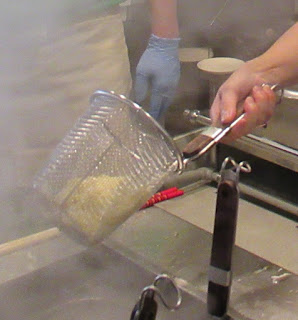I find ferns are attractive. I don’t know why, but their presence in forests recalls my memory when I admired paintings of Pre-Raphaelites … Oh-so-magical world of Fairly Feller’s Master-Stroke (with the voice of Freddy Mercury 😍)! Don’t you think ferns are the images the Victorian Avant-gardes should have loved to include in their fantasy world? However! To my surprise, I discovered there is no clear image of ferns in “The Fairly Feller’s Master-stroke.” In “Ophelia” there might be a depiction of Lygodium, but perhaps they did not exist in England 150 years ago ... did they? In my short google search, I could find only one painting with ferns in the Pre-Raphaelite school. It’s “Rabbit amid Ferns and Flowering Plants” for Boston MFA. There the ferns look like Polypodium Vulgare. Why did the imaginary world of Pre-Raphaelite not incorporate more Pteridophytes? Ferns are ubiquitous all over the world in the end. England surely has had them for millennia. And at least for me, their form is VERY dreamy. I’ve found something else in the “Rabbit” painting. The painter depicted sori, just a bit. It might be the reason for Pre-Raphaelite not painting ferns much.
Lygodium.
They are ubiquitous in Niiharu Citizen Forest 新治市民の森.
When we observe their back, ferns have sorus unless you happened to encounter a sorus-less part of upside-down fern (Arachniodes standishii; oh, do you know they have sori on their back in the other parts?). Those lumps could be the things that drive away some people. “Oh, these granular patterns are so creepy. They are hideous!” You see? There could be psychological reasoning for such feeling among humans ... Maybe, those English painters of the 19th century did not like sori in ferns. BUT! You just get used to it, and it’s possible to admire the wonder of the wild ferns more with sori. Recently, I found it’s fun to observe fern sori. Especially with microscope, that’s the magical world!
Thelypteris viridifrons in Niiharu
Their sori situate themselves neatly.
Could you figure out their indusium
(a shield covering a sorus) look fluffy?
It’s typical for Thelypteris viridifrons.
This photo is my treasure.
Microscopic view (about 90x) of
the indusium for Thelypteris viridifrons.
Don’t you think they really look like jewels?
Weeping fern (Lepisorus thunbergiaus) near Niiharu.
When they are dry,
they shrivel like those on the right of this photo.
Weeping fern in Yadoriki Water Source Forest やどりき水源林.
Its sori are well-developed so that we can see them from the front.
Sori of a weeping fern.
They are in the upper half of the frond.
The species do not have indusium.
Holly Fern (Cyrtomium devexiscapulae) in Yadoriki
The positioning of sori of a Holly Fern.
It’s really interesting to see the variety
of sori for each species, don’t you think?
A zoomed-in photo for frond back of holly fern.
Sori of this species looks typically like mount of powder.
A microscopic view (about 80x)
of a sorus for the above holly fern.
Psychedelic …
Ubiquitous Pteris cretia L. in Yadoriki.
Could you figure out two kinds of frond for this species?
The ones with slightly jagged frame
which we can find in the back do not have sori
and specialize in photosynthesis.
The front fronds with somehow curled edges
are carrying sori along the rim in their back …
Zoomed-in version of the back of Pteris cretia L.
It looks like from the world of “Dew-drenched Furze” in Tate.
But it’s not furze!
A microscopic view of sori for Pteris cretia.
Woooooooooooooow.
Taking microscopic photos of sori is not at all difficult. I use a toy-like field microscope which grade-schoolers can bring for their school excursion. I focus the object under this microscope, and situate the lens of my small digital camera on the eyepiece. In “auto” mode, my clever machine does all the works of focusing, shutter speed, and aperture. There would be a better way to take microscopic photos, of course. At least for now it’s enough for me. I imagine if we play with the ferns in Britain, we can also enjoy similar kind of pleasure with microscopes. Perhaps those artists in the 19th century England did not have an access of such handy tools to know the beauty of their forest … Recently, we Kanagawa Forest Instructors entered in a forest of one art gallery in Hakone 箱根 to mow overgrown sasa-bamboos. It was a requested volunteering activity from the museum. When we returned from the site after the operation, our boots became muddy inevitably. To our cars, we had to walk on a white stone-paved road running to the entrance of the museum. Then, staff of the gallery yelled at us, “Hey, don’t put your dirty shoes here!” … Yeah. Clean paved way surrounded by forests would be an important item for pin-heeled tourists to high-blow art gallery in Hakone … We apologize our dirty shoes, but, if you need to know, there was no other route to the parking for us … Or was it a reason why Pre-Raphaelites did not include whimsical ferns in their world?
My microscope
If you find an environmental issues in Kanagawa Prefecture, please make a contact with Kanagawa Natural Environment Conservation Center 神奈川県自然環境保全センター
657 Nanasawa, Atsugi City, 243-0121 〒243-0121 厚木市七沢657
Phone: 046-248-0323
You can send an enquiry to them by clicking the bottom line of their homepage at http://www.pref.kanagawa.jp/div/1644/










































































